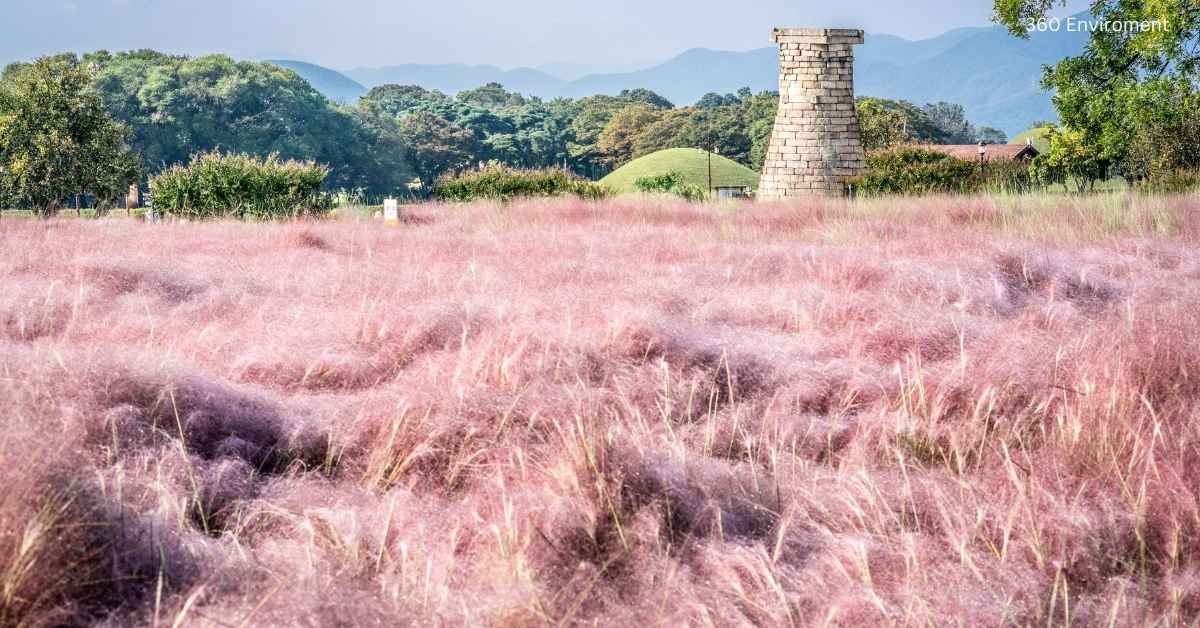Grasses are fundamental to ecosystems around the world, forming the basis of habitats and feeding systems, but some species stand out for their unique beauty and ecological role. Among these is the phenomenon of pink grass, a stunning display of nature that not only captivates with its color but also holds significant environmental value.
This article will delve into the world of pink grass, exploring various species, their ecological roles, environmental significance, and the challenges they face in a changing world. We will also examine how pink grass contributes to biodiversity, soil health, and conservation efforts, providing a holistic look at the importance of this plant in its many forms.
1. What Is Pink Grass?
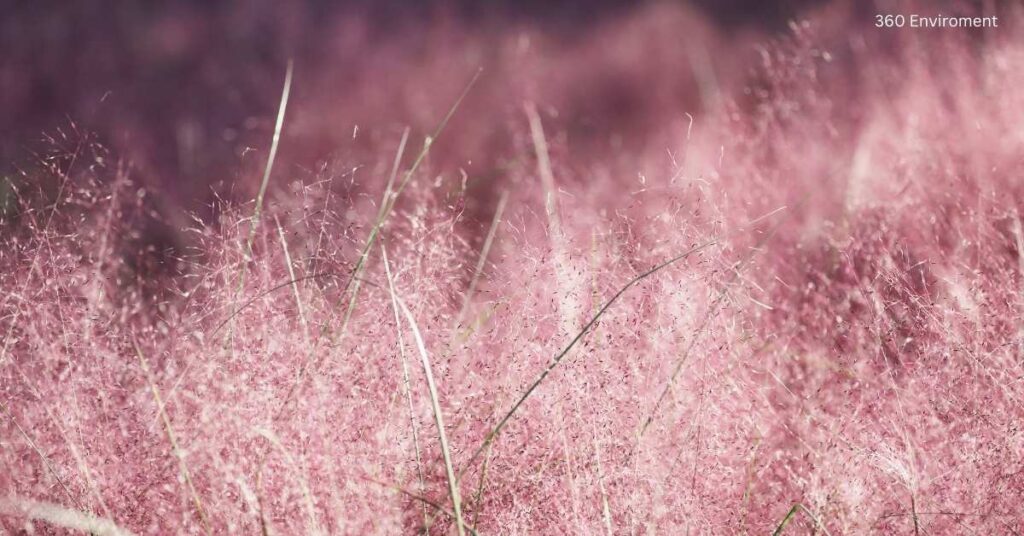
1.1 Introduction to Pink Grass
When we talk about pink grass, we’re referring to several species of grasses and flowering plants that, under certain conditions, produce pinkish hues. These species thrive in a variety of ecosystems, ranging from grasslands and prairies to wetlands and coastal dunes. Some species are annuals, appearing seasonally, while others are perennial, offering their colors year after year.
Pink grass gets its color from the flowers, seeds, or foliage, depending on the species. The vivid pink tones often appear in late summer or early autumn, creating spectacular natural displays.
1.2 Species of Pink Grass
A few notable species of grass or grass-like plants known for their pink hues include:
- Muhlenbergia capillaris (Pink Muhly Grass): Native to the United States, this grass is well-known for its bright, cotton-candy-like pink plumes in autumn. It is often found in prairies, open woodlands, and alongside highways, offering a beautiful and resilient option for landscaping and restoration projects.
- Sporobolus heterolepis (Prairie Dropseed): While this plant isn’t entirely pink, the seed heads and flower stalks develop a reddish-pink tinge in the late summer. It’s native to the North American prairies, and its graceful arching leaves and pink tones make it a favorite for prairie restoration.
- Molinia caerulea (Purple Moor Grass): While more purple than pink, this grass can develop a pinkish hue under certain lighting conditions, especially in its flower spikes. Native to Europe and parts of Asia, it thrives in wetlands and moist heathlands.
- Melinis repens (Natal Redtop): Native to Africa but found across warm regions of the world, this grass produces pink or reddish seed heads that float in the wind. Its adaptability makes it both a valuable resource for forage and a potentially invasive species.
These species, each unique in their appearance and habitat, contribute to the rich diversity of ecosystems in which they thrive.
2. Ecological Roles of Pink Grass
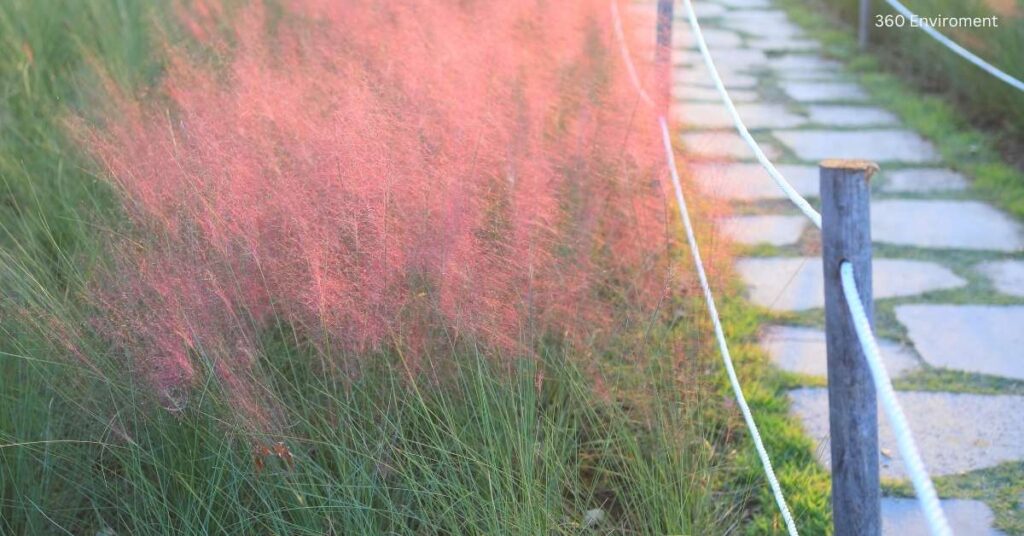
2.1 Support for Biodiversity
Like all grasses, pink grass plays an essential role in supporting biodiversity. It provides food and habitat for a wide range of species, including insects, birds, and small mammals. The structure of these grasses offers shelter for ground-nesting birds and insects, while their seeds and foliage provide food for herbivores.
For example, Pink Muhly Grass offers a nesting ground for pollinators like bees and butterflies. During bloom, these grasses attract various insects, which in turn feed on nectar and pollen, supporting the local ecosystem’s food web. Birds often use the grass as cover and a source of food, helping sustain populations of small animals in prairies and meadows.
2.2 Soil Stabilization
Grasses, including pink grass species, play an essential role in soil stabilization. Their root systems are typically dense and fibrous, making them effective at holding soil together and preventing erosion. This is especially important in ecosystems prone to soil degradation, such as coastal dunes and riverbanks.
For instance, Natal Redtop is often planted in areas needing erosion control due to its extensive root system. It helps bind the soil in place, reducing the risk of landslides, flooding, and the loss of topsoil, which is crucial for maintaining healthy ecosystems.
In environments like wetlands and prairies, pink grass helps filter water, capturing pollutants before they can enter rivers, lakes, or groundwater. This filtration process is crucial for protecting water quality, particularly in regions where agriculture or industrial runoff is prevalent.
3. Environmental Benefits of Pink Grass
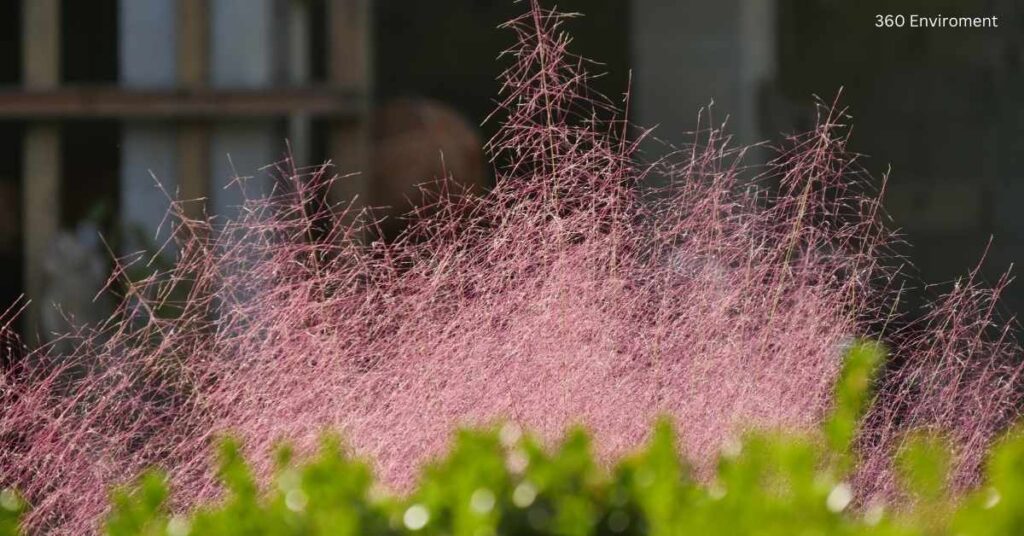
3.1 Carbon Sequestration
Grasses are important carbon sinks, and pink grass species are no exception. Through photosynthesis, grasses absorb carbon dioxide (CO2) from the atmosphere and store it in their roots and soil. This process, known as carbon sequestration, helps mitigate the effects of climate change by reducing the amount of CO2 in the atmosphere.
Perennial grasses, like Pink Muhly Grass and Prairie Dropseed, are particularly effective at storing carbon because their roots remain in the soil year-round, even when the above-ground foliage dies back in winter. This means that carbon is continuously sequestered in the soil, contributing to long-term carbon storage.
3.2 Water Conservation
Many species of pink grass are drought-tolerant and adapted to thrive in areas with limited water. Their ability to survive in harsh conditions makes them valuable in landscaping and agricultural practices, particularly in regions facing water scarcity.
For example, Muhlenbergia capillaris is a low-water plant that can thrive in dry, sandy soils. It requires minimal irrigation once established, making it an excellent choice for water-wise landscaping. In areas where water conservation is a priority, planting pink grass can reduce the need for supplemental irrigation and help conserve precious water resources.
3.3 Aesthetic and Recreational Value
Beyond their environmental benefits, pink grasses offer immense aesthetic value. The vivid pink plumes of Pink Muhly Grass and other species create stunning visual displays in natural landscapes, parks, and gardens. These grasses can enhance the beauty of open spaces, drawing people outdoors to enjoy and connect with nature.
The presence of aesthetically pleasing plant species can also support ecotourism and outdoor recreation. For example, during peak bloom seasons, fields of pink grass can attract visitors to parks, nature reserves, and botanical gardens, contributing to local economies and promoting environmental awareness.
4. Challenges and Threats to Pink Grass Species
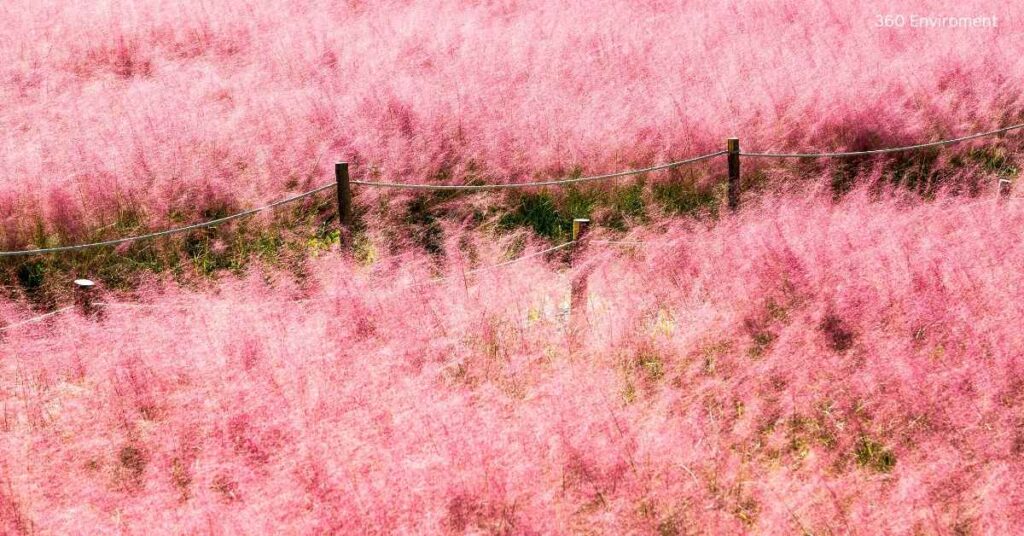
4.1 Habitat Loss
One of the biggest threats to pink grass species is habitat loss due to urbanization, agriculture, and land development. As natural landscapes are converted into farmland or urban areas, the ecosystems where these grasses thrive are often fragmented or destroyed.
For example, prairie ecosystems, home to species like Prairie Dropseed, have been significantly reduced in size due to agricultural expansion. This loss of habitat threatens the survival of pink grass species and the biodiversity they support.
4.2 Climate Change
Climate change presents another significant challenge for pink grass species. Rising temperatures, changing precipitation patterns, and more frequent extreme weather events can alter the ecosystems where these grasses grow, making it difficult for them to survive.
Drought-tolerant species like Natal Redtop may become more common in regions experiencing increased aridity, but other species that rely on specific moisture or temperature conditions could decline. Additionally, shifting climate zones may force pink grass species to migrate to new areas, potentially disrupting local ecosystems and causing a loss of biodiversity.
4.3 Invasive Species
Some species of pink grass, particularly Melinis repens (Natal Redtop), have shown the potential to become invasive in non-native regions. In areas where these grasses are introduced for erosion control or ornamental purposes, they can sometimes outcompete native plant species, leading to a reduction in biodiversity.
Invasive pink grass species can alter ecosystem dynamics by displacing native plants, which in turn affects the animals and insects that rely on those plants for food and shelter. Managing invasive species and preventing their spread is essential for maintaining healthy ecosystems.
5. Conservation and Sustainable Use of Pink Grass
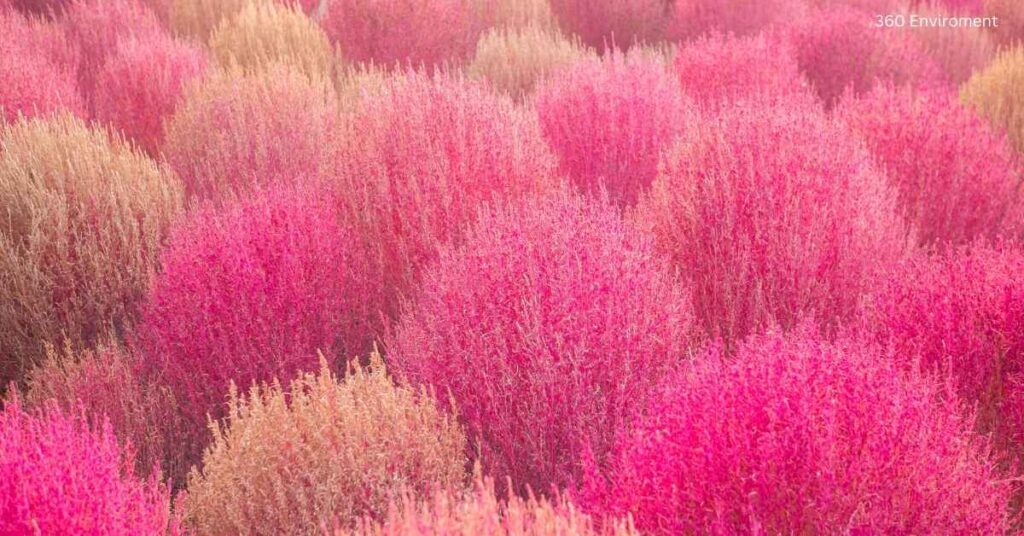
5.1 Restoration Projects
Pink grass species are increasingly used in ecological restoration projects to restore degraded habitats and promote biodiversity. For example, Pink Muhly Grass is often used in prairie restoration projects to reestablish native plant communities and provide habitat for wildlife.
By planting pink grasses in restoration projects, conservationists can help stabilize soils, improve water quality, and enhance habitat connectivity. These efforts contribute to the long-term health and resilience of ecosystems, benefiting both wildlife and humans.
5.2 Sustainable Landscaping
In recent years, there has been a growing interest in using native grasses, including pink grass species, in sustainable landscaping practices. These grasses are well-suited to local environmental conditions, require minimal inputs, and provide habitat for pollinators and other wildlife.
Incorporating pink grasses into home gardens, public parks, and urban landscapes can reduce water consumption, lower maintenance costs, and enhance the ecological value of green spaces. Additionally, using native grasses helps support local biodiversity and promotes the conservation of endangered species.
5.3 Climate-Resilient Agriculture
As the impacts of climate change become more pronounced, farmers and land managers are seeking ways to make agriculture more resilient. Pink grass species, particularly those adapted to dry or marginal soils, offer valuable solutions for climate-resilient agriculture.
By incorporating pink grass species into agroecological systems, farmers can improve soil health, reduce erosion, and conserve water. These grasses can be used as cover crops, forage for livestock, or even integrated into permaculture systems, where they contribute to the overall sustainability and productivity of the land.
6. The Future of Pink Grass in a Changing World
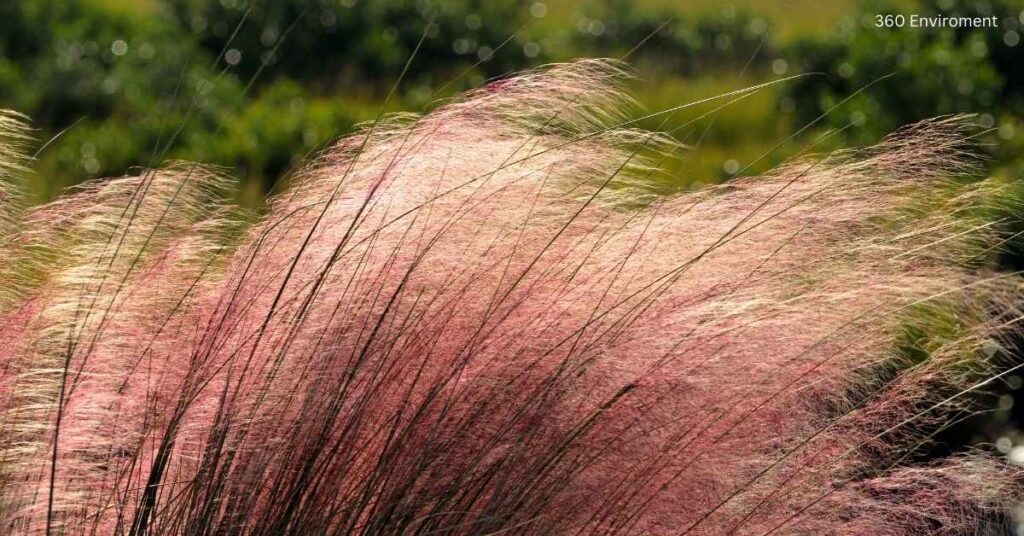
6.1 Adapting to Environmental Change
As ecosystems continue to change in response to human activities and climate change, the future of pink grass species will depend on their ability to adapt to new conditions. Research into the resilience and adaptability of these species is crucial for understanding how they can thrive in a rapidly changing environment.
Conservation efforts focused on preserving genetic diversity within pink grass species will also be essential. By protecting a range of genetic variations, we can increase the chances that these grasses will survive and adapt to future challenges.
6.2 Promoting Awareness and Education
Raising awareness about the importance of pink grass species and their role in ecosystems is vital for fostering public appreciation and support for conservation efforts. Educational programs, community workshops, and outreach initiatives can help people understand the ecological value of these grasses and inspire them to participate in conservation activities.
By engaging communities in restoration projects, sustainable landscaping, and biodiversity conservation, we can cultivate a deeper connection to nature and promote stewardship for the environment.
6.3 Collaboration for Conservation
Addressing the challenges facing pink grass species requires collaboration among researchers, conservationists, land managers, and policymakers. By working together, we can develop effective strategies for habitat protection, species recovery, and sustainable land use.
Cross-sector partnerships can facilitate the sharing of knowledge, resources, and expertise, leading to more effective conservation outcomes. Engaging local communities in these efforts is essential for building support and fostering a sense of ownership over natural resources.
Conclusion
Pink grass represents a fascinating intersection of beauty and ecological importance. As we explore its diverse species, roles in ecosystems, and environmental benefits, it becomes clear that pink grass is not just a colorful addition to our landscapes—it is an integral part of our natural heritage.
From supporting biodiversity and stabilizing soils to enhancing aesthetics and providing environmental benefits, pink grass species offer a wealth of advantages. However, they also face significant challenges, including habitat loss, climate change, and invasive species.
By prioritizing conservation, sustainable use, and public education, we can ensure that the vibrant beauty of pink grass continues to thrive in our ecosystems for generations to come. Through concerted efforts and a commitment to stewardship, we can protect these remarkable plants and the environments they enrich.
Read More: Bahama Grass: An Ecological and Agricultural Insight

